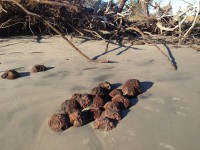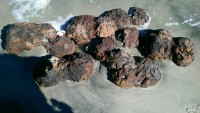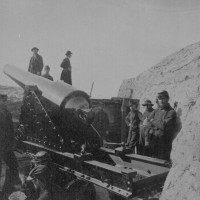 A cluster of Civil-War era artillery churned up from the sands of Folly Beach in South Carolina by Hurricane Matthew was safely detonated on Sunday evening. The 16 corroded cannonballs were found Sunday morning on the beach at East Ashley Avenue by former Folly Beach mayor Richard Beck who was walking the shoreline taking pictures of the wreckage Matthew left behind.
A cluster of Civil-War era artillery churned up from the sands of Folly Beach in South Carolina by Hurricane Matthew was safely detonated on Sunday evening. The 16 corroded cannonballs were found Sunday morning on the beach at East Ashley Avenue by former Folly Beach mayor Richard Beck who was walking the shoreline taking pictures of the wreckage Matthew left behind.
“I knew they were cannonballs,” he said. “One of them had a very distinct hole in it that went directly into it. Just knowing a little bit about the Civil War, I know that they put fuses in cannonballs for them to explode when they desired them to.”
Recalling a time back in his mayor days when Civil War cannonballs were found in the basement of a home and had to be detonated, Beck called the police to report the find. One of the officers who answered the call is a Civil War reenactor and confirmed the rusted lumps were indeed cannonballs.
 The Charleston County Sheriff’s Office and Charleston police bomb squad were on the scene by 12:30, but couldn’t do anything until the tide was out. At around 7:00 PM, with the help of the United States Air Force Explosive Ordnance Team, authorities were able to safely detonate the cannonballs. While it’s unlikely the black powder inside of them would have ignited given their age, condition and sodden environment, as a matter of public safety, the policy is to avoid all risks and destroy the ordnance.
The Charleston County Sheriff’s Office and Charleston police bomb squad were on the scene by 12:30, but couldn’t do anything until the tide was out. At around 7:00 PM, with the help of the United States Air Force Explosive Ordnance Team, authorities were able to safely detonate the cannonballs. While it’s unlikely the black powder inside of them would have ignited given their age, condition and sodden environment, as a matter of public safety, the policy is to avoid all risks and destroy the ordnance.
“We call it ‘rendering safe’ and we did that right there on the beach front,” [Charleston County Sheriff’s Office spokesman [Eric] Watson said. “They’re putting the dirt from the detonation back in the hole and they’re transporting the device to (Joint Base Charleston).”
It’s not a single device, to be clear, but most of the balls are fused together by the corrosion. According to the Sheriff’s Office Facebook page, some of the cannonballs were detonated on the spot. The rest were transported to a nearby naval base where they were destroyed Sunday night.
 Just to give you an idea of the lay of the land, Folly Beach is less than 12 miles from Charleston Harbor (by road; it’s closer by sea). A couple more miles over the water will take you to Fort Sumter where the first shots of the Civil War were fired on April 12, 1861, when Confederate cannon barraged the Union garrison at the fort. Folly Island itself didn’t see a great deal of combat during the war — there was a single battle (more of a skirmish, really) on May 10th, 1863, when Confederate troops scouting the island attacked Union troops they found there — but the island was occupied by 13,000 Union Army in August of 1863. They used it as a supply station, building a fort and an artillery battery in support of the Union troops besieging Charleston. It was a staging area for both Battles of Fort Wagner (July-September 1863), which took place on the adjacent Morris Island. The second Battle of Fort Wagner was famously depicted in the film Glory and the remains of at least 19 men from all African-American units including the 55th Massachusetts, 1st North Carolina Colored Infantry and the Second U.S. Colored Infantry were discovered at the west end of Folly Beach in 1987.
Just to give you an idea of the lay of the land, Folly Beach is less than 12 miles from Charleston Harbor (by road; it’s closer by sea). A couple more miles over the water will take you to Fort Sumter where the first shots of the Civil War were fired on April 12, 1861, when Confederate cannon barraged the Union garrison at the fort. Folly Island itself didn’t see a great deal of combat during the war — there was a single battle (more of a skirmish, really) on May 10th, 1863, when Confederate troops scouting the island attacked Union troops they found there — but the island was occupied by 13,000 Union Army in August of 1863. They used it as a supply station, building a fort and an artillery battery in support of the Union troops besieging Charleston. It was a staging area for both Battles of Fort Wagner (July-September 1863), which took place on the adjacent Morris Island. The second Battle of Fort Wagner was famously depicted in the film Glory and the remains of at least 19 men from all African-American units including the 55th Massachusetts, 1st North Carolina Colored Infantry and the Second U.S. Colored Infantry were discovered at the west end of Folly Beach in 1987.
There is no possible way those artillery projectiles were a hazard. Overreaction in the extreme.
The 54th Massachusetts was the brace black regiment at Fort Wagner. I don’t know that the 55th was present. Please correct the blog.
Excuse the bad typing. I meant brave, not brace.
Overreaction is common. In New Jersey two years ago a bomb squad made a big deal of “detonating” what was clearly a shot put found in a back yard in Cape May County.
And yes, 54th Mass. at Battery Wagner.
I hope the reenactor returned properly kitted out in frock coat.
A friend of ours was clearing out his half ruinous garden shed when he found a German incendiary bomb. Presumably a previous owner of the house had found it in the garden and popped it into the shed. As one does.
His wife was alarmed when she got home to find that the police and the Army Bomb Squad were attending.
In a way this was a happy ending because our friend’s original plan for the decomposing shed was just to burn it down.
Folly Beach indeed!
But I agree with Polymarkos that detonating those cannonballs was kind of ridiculous. Black powder in rusty cannonballs buried on a beach for 153 years? At this point there can’t be anything left of it except maybe some nonreactive carbon.
My Grandmother hailed from north-central Virginia. There was a lot of heavy fighting there in the Civil War. There were occasional accidents with people and animals accidentally disturbing cannonballs and shells them well into the 1940’s, mostly exploding cows. Not to mention the knuckleheads who purposely try to dig them out. Occasionally one used to go “boom” but it’s been years since I’ve heard of it happening.
I do know of a relic collector going up with a Civil War shell as recently as the 1980’s in VA. He was in the process of moving the thing. It had been assumed to be a dud for over one hundred years, You never can tell.
Why did they blow them up? Probably afraid of getting sued if someone broke a foot on them. That and the ex-Mayor told the Sheriff how cool it was the first time he got to blow cannonballs up. Plus they’ve got to use that Dept. of Homeland Security issued C-4 on something.
Ah for the good old days. I grew on the the site of a Civil War fort on James Island in Charleston. We used to find mini balls, grape shot, buttons, etc on a regular basis. Even an occasional cannon ball wasn’t unusual. My brothers found a bayonet right behind our house. Every kid I knew had a drawe full of CW relics.
Y-e-s … and I’m sure that if someone would have been maimed or killed while trying to disarm a 150 year old +/- piece of artillery you guys would be the first to say, “Those idiots! Didn’t they know how unstable that would be??” I think detonation was the right thing. There are plenty of relics and artifacts in the museums around Charleston without risking the lives of people over something like this. The sad part is that the country is becoming about as divided currently as it was back then. We should learn from the history that we’ve preserved, not repeat it.
Yeah, in this case detonation was probably a rather wise choice. With only slightly more ‘modern’ ammunition, however, and also with current one, where there is Uranium and nerve gas, in situ detonation might not really be the best of all choices.
Actually, there was no danger. This destruction of the cannon balls was a gross overreaction.
I have yet to see a document case of a piece of civil war ordnance detonating.
Here is one http://www.foxnews.com/story/2008/05/02/virginia-man-killed-in-civil-war-cannonball-blast.html
It is rare, but it happens- a friend of mine lives in Fredericksburg and has been a relic hunter for years there. He lost a friend before the above incident who was drilling a cannonball to empty it, apparently not realizing how hot the bit could get and how hermetically sealed the ball could be.
I couldn’t find a link to that prior death, but if you’re interested, I am sure a simple google search would yield a few more.
I worked with the dredging industry for over 20 years and they often sucked up ordnance from all phases of US European history. Most was solid shot, but the civil war hollow shot was treated as live unless the plug was gone. In one incident near Aberdeen Maryland they got a CW mortar round Sucked into their hopper (the hold basically) and had to get a navy EOD team to remove it. They opened the plug remotely and found dry powder that was still active, so underwater rounds can be intact.